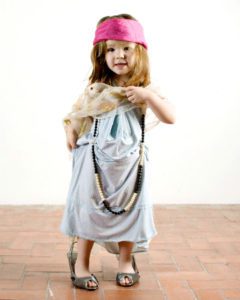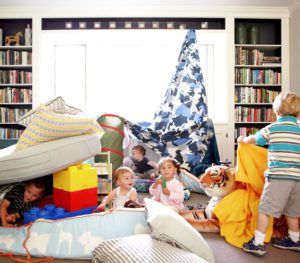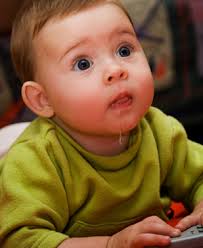“Beyond Toys and TV”
Our kids are shaped by what they see and do. Very young children can become wired for over-stimulation by screen time as well as the kind of commercial playthings that use sound, light, and movement to hold their attention. How does this affect them?
When play has to do with blinking, beeping toys or rapidly changing images, children may have a diminished ability to amuse themselves. They may not be attuned to the slower pace of conversation, the expansive pleasure of make-believe, or the subtle wonders found in nature. They have trouble generating their own fun.
Even if you limit screen time and emphasize more naturally stimulating playthings, your child can still be overwhelmed by too many choices. You’ll find reducing a toy overload helps children play more creatively, cooperate more easily, and become more resourceful. Here are some toy overload solutions with plenty of toy-free play ideas.

Rotate toys. Make it a family policy to have fewer playthings available at any one time. This way your child can deal with a smaller selection and play areas are less cluttered. Of course use a sensitive approach. Pick up a few things that have been long ignored and put them away for that proverbial rainy day. You may choose to do this during nap-time. When you do get out a toy, doll, or stuffed animal that has been “resting” you’ll want to quietly put away another object. If children notice, it’s common for them to feel sudden affection for the toy you’re taking. When you face objections, don’t make the policy painful. Work together to find another toy that your child can agree to put away. You’ll find the same old toys take on a new luster when a young child hasn’t seen them for a while.
Keep some toys for specific purposes. It’s helpful to reserve certain toys to be used only for situations that require more serious distraction. These might be perfect opportunities to use toys that require a parent close by, or time to permit your children to play with any passive toys they’ve been given. Keep such items for situations when your child is forced to be passive anyway such as the car seat, waiting in line, or while you’re on a conference call. Even very young children come to recognize that such toys are kept in a diaper bag, a parent’s bag, or on a high shelf for special occasions. Explanations before and after use, “We only use this in the car” or “This is a Daddy’s-on-the-phone toy” help keep the boundaries drawn. And help you put the toy away for the next time.
Join or set up a toy lending library. Collections of donated toys can be found through some museums, community centers, and public libraries. Toy lending programs give families access to a wider range of ordinary playthings and more expensive toys than they might ordinarily afford, as well as toys for special needs children. Search online to find a toy library near you or for helpful advice on starting a collaborative toy lending service.
Assemble play kits using non-toy items. You can throw together kits that stimulate imaginative play while re-purposing old objects. Of course, your child’s safety is the primary concern. These suggestions are not appropriate for children who put objects in their mouths or are too small to use the items safely. To keep up the appeal factor, put the kits away between use. They are great to get out when kids have play-dates or when you need them to play quietly under your supervision.
Office: Use a briefcase or file box. Fill it with office-type items such as memo pad, non-working cell phone, calendar, writing implements, round-tip scissors, and calculator. A big thrill is a tape dispenser—this alone can keep kids happily occupied. A major coup is finding a manual typewriter at a thrift store. You’ll need to help them understand how to type one letter at a time to keep the keys from becoming tangled.
Costume: A costume box or trunk is a childhood classic. Keep adding cast-off and thrift store items likely to enhance make-believe. Include work wear, dress-up, jewelry, wallets, purses, shoes and boots, lengths of fabric that can be used as capes or veils, vests, tool belt, badges, and plenty of hats.
Building: Fill a large box with heavy cardboard tubes as well as other sturdy cardboard boxes. Add a roll or two of masking tape, string, plus hardware cast-offs such as nuts and bolts. Encourage children to build whatever they choose from the cardboard supply. They might need help punching holes in the cardboard to insert bolts or string. They might also enjoy hammering their creations apart with a rubber mallet when they’re done.
Store: Save empty clean food packages, re-gluing boxes shut so they look new. Children can set up a play shop with these items, adding their own toys or books for additional merchandise. Lend them your fabric shopping bags to load pretend purchases. They may want to swipe a pretend debit card or use homemade money to cover their transactions.
 Deconstruction:
Deconstruction:
Encourage kids to make hideouts. Most children like making their own realms under blankets, in closets, and behind furniture. Outdoors they make dens and forts out of a few branches or leftover planks. Provide sheets or blankets to drape over the furniture for an indoor hiding place, with couch cushions for support. On occasion, try to get a large packing box from stores selling refrigerators and washing machines. Your child can direct you to cut a few openings to transform the box into a boat, space ship, or castle. Once inside a hideout, they’re in another world.
Get elemental. Little kids adore water play. Pull up a stool to the sink and let them wash a few unbreakable dishes or toys with mild soap. They’ll stay busy pouring water from soup ladle to funnel to pitcher to cup. Add to the fun by putting a few ice cubes in the sink, giving them foil to shape into boats, or letting them add food coloring. Encourage them to do “science” by gathering a few water safe objects (perhaps a block, a spoon, a popsicle stick, a ball, a rubber band) and guess which ones will float before putting them in the water. This is the basis of real experimentation! You might let them play in the tub while you sit nearby reading a book or getting some work done on the laptop. Outdoors there are many more water options. On a hot day, water wiped on the house or driveway with a brush temporarily darkens the surface, giving toddlers the satisfying impression they are “painting.” It dries quickly so they can paint again. You can also give them a sponge to let them wash a tricycle, a watering can to give the plants a drink, or a sprinkler to run through. Don’t forget the pleasures of water added to dirt. Mud pies are a childhood classic.
Help kids set up obstacle courses. A rainy day indoor course might consist of a few chairs to wriggle under, a rope to hop over, four pillows to leap on in a row, three somersaults through the hall, and a quick climb up the bunk bed ladder. Outdoors they can set up a bike, trike, or scooter obstacle course. Mark the course with sidewalk chalk or masking tape. The course may lead them around cones, through a sprinkler, under crepe paper streamers hanging from a tree branch, and on to a finish line. More fun? Setting up their own obstacle courses.
Bring back legacy games. All that’s needed for most sidewalk games are chalk, while backyard games only require a ball and a sense of fun. For instructions you may have forgotten or never learned, check out Sidewalk Games by Glen Vecchione and Sidewalk Chalk: Outdoor Fun and Gamesby Jamie McGillian. And remember to add those classic hand-clapping games, typically played while chanting a rhyme. A few rounds of Miss Mary Mack or Say Say My Playmate aren’t just fun, studies show they’re also brain boosters.
Stage treasure hunts. First hide a prize. Then place clues throughout the house or yard. For very young children, those clues can be pictures or rebus sentences. For older children, the clues can be written as poems or riddles. Each clue leads to the next set of clues before the treasure is discovered. The prize doesn’t need to be a toy or goodies, since the hunt itself is the real fun. Try “hide a packed lunch day” and let everyone search for the cache of lunches. Those who find sustenance first need to help others so the kids can eat together. Or hide the book you’re been reading aloud so kids can search for the treasure of the next chapter. Once they’re familiar with treasure hunts, children can create them for each other.
Let them help. Even the smallest children want to participate in the real work that makes a household function. They want to tear lettuce for salad, clean crumbs with a small wisk broom, measure beans and pour them in the coffee grinder, sort socks, carry kindling for the fireplace, basically anything they see their elders doing. They benefit in remarkable ways, from greater dexterity to the development of character traits that lead to long-term success. What’s more, they have fun doing it.
Article by Laura Grace Weldon.



